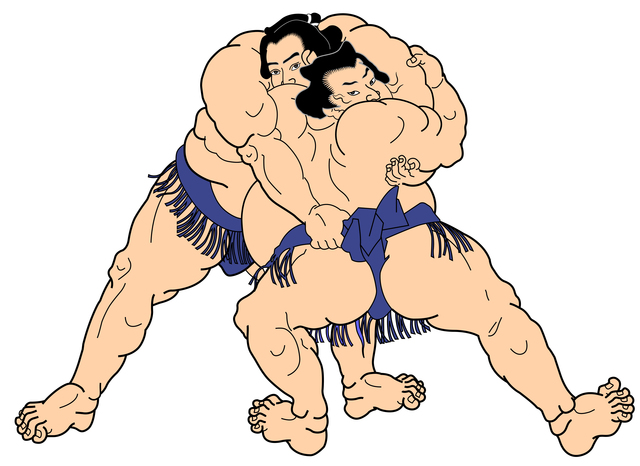The body of Edo
In part 3 of our 'Transcreating Tokyo' series, Takeo Funabiki explores the history of the physical arts

Posted: Sun Mar 02 2014

In the Edo era, three forms of bodily entertainment were born: kabuki theatre, which has been designated an Intangible Cultural Heritage by the United Nations and remains highly respected both inside and outside Japan. Sumo wrestling, which has maintained its popularity in the face of problems like match-fixing scandals and the lack of Japanese champions. And geisha ‘service’, though there may be some debate as to whether geisha should be listed as one of Tokyo’s traditions since the practice has come to be criticised as prostitution. Here, I will explore the roots of these three forms of entertainment and illuminate the importance of the ‘body’ in Japanese culture.
What do we mean by ‘body’?
Entering the Edo era, Christianity in Japan had been annihilated, and all religion, including Buddhism, was controlled by the shogunate. This control led to the waning influence of religion and strengthened the social order constructed by the central government, gradually erasing the idea of the transcendent god from the minds of the Japanese. Here, the transcendent god refers to a higher existence, a being from whom the very foundations of our world originate.
Due to the absence of such a worldview, and the resulting lack of focus on the afterlife, the idea that the real, transient world is what matters came to be widely accepted. Hence, the human body, which is simultaneously the source of our enjoyment and its object, assumed greater importance. Worldly entertainment such as books and pamphlets, as well as paintings like ukiyo-e prints were already around, but more bodily performances now began to prosper. Kabuki, sumo and geisha were born, and became major themes of ukiyo-e painting as well.

The art of kabuki
Kabuki began as a form of dancing performed by women, but females were soon banned from the stage. This led to men taking up the roles of women as well, resulting in an increasingly fictitious form of art. Male roles often featured powerful, battling heroes, while female characters were fierce heroines who overcome adversity. That is to say, both male and female characters rose above ordinary existence.
Even more so than in other forms of performing art, female roles capture the essence of kabuki. Of course, the women (played by men) in kabuki only represent one half of the whole, but they are at the forefront in expressing the fiction and perverse attraction at the heart of this art form – aspects that captured the imaginations of audiences since the early days of kabuki. This fictitiousness and perversion is most vividly expressed when an old man plays the role of young girl or princess. Such a situation is a perfect example of bodily contradiction.

The sport of sumo
As for sumo, its origins lie in martial arts performed at religious services. Commoners enjoyed these performances as a form of play, while soldiers practiced the art in order to be prepared for battle. However, when sumo first became popular among the townspeople of Edo, it was as a spectator sport, not as a martial art.
Win or lose, the bodily motion of a sumo wrestler has a certain innocent beauty to it. Because of this, you didn’t necessarily have to be successful to become an in-demand wrestler – great height or weight could be enough. Some unusually large or strong children became popular simply because they had bodies that were bigger than those of many grown men. The famous Daidozan Bungoro measured 120cm and 70kg at the age of seven, although he did not grow to be a particularly large adult. Such wrestlers attracted attention simply by stepping into the ring.
It might even be said that Edo-era sumo was more about the performance of entering the ring than it was about the actual wrestling; it was about seeing extraordinary bodies. Even today, we do not watch sumo to see expert technique or elaborate moves. We want to see the unpretentious spectacle of bodies crashing into each other, falling over and being dirtied. The wrestlers’ compliant attitudes bring to mind a small child in a huge body – another bodily contradiction.

The grace of geisha
Finally, there’s the geisha. In Edo, there were many kinds of geisha, ranging from luxury courtesans to ‘regular’ prostitutes. The difference in class could perhaps be measured simply by looking at rates, but in any case, these ladies were something different for the men of Edo, far removed from the women they interacted with in their daily lives.
We must ask what the services provided by the geisha were like. Although it may not always have been evident at a glance, or was consciously kept secret, these women’s work always revolved around sex – it cannot be called anything else than prostitution. Sex is of course what forms the deepest basis of all human activity, so judging them is unnecessary. However, we need to be clear about what was so different about sex that involved geisha. In public parlance, sex is discussed within the framework of marriage and treated primarily as a means of reproducing the family, while in the world of the geisha, such considerations do not figure into sex.
In a manner of speaking, men commit the mistake of believing that sex can take place without social consequences. They hope that money can buy a licence to unrestrained sexual relations, and apply this way of thinking to the geisha. Naturally, the exchange of money taking place proves that this illusion of social isolation is mistaken. That false hope involves a form of dependence that is absent in husband-wife or boyfriend-girlfriend relationships. It can be said that the bodily entertainment industry, with its origins in the Edo era, is what continues to feed this pattern of behaviour.
In today’s Tokyo, this bodily entertainment industry continues to flourish in a vast variety of forms – a fact that can be confirmed simply by taking a stroll through any of the city’s amusement districts. Just as was the case with the men of Edo, today’s city-dwellers continue to be drawn to the geisha’s all-forgiving figure, one perhaps best described as ‘a mother that doesn’t give birth’ – our final bodily contradiction.
Takeo Funabiki
Cultural anthropologist
1948, born in Tokyo
1972, BA, University of Tokyo, Faculty of Liberal Arts
1982, PhD in anthropology, Cambridge University, Graduate School of Social Anthropology
1983, University of Tokyo, College of Arts and Sciences, lecturer
1994, Professor
1996, University of Tokyo, Graduate School of Arts and Sciences, professor
2012, retired from the Graduate School, Professor Emeritus
Field work conducted in Hawaii, Tahiti, Japan (Yamagata Shonaiheiya), East Asia (China, Korea) and Melanesia/Polynesia (Vanuatu, Papua New Guinea). Professional interests include 1) mechanism of mutual interference of human culture and nature, 2) the representations of ritual and theatre, and 3) changes in culture and society that occur during the course of modernisation.
Tweets
- About Us |
- Work for Time Out |
- Send us info |
- Advertising |
- Mobile edition |
- Terms & Conditions |
- Privacy policy |
- Contact Us
Copyright © 2014 Time Out Tokyo














Add your comment